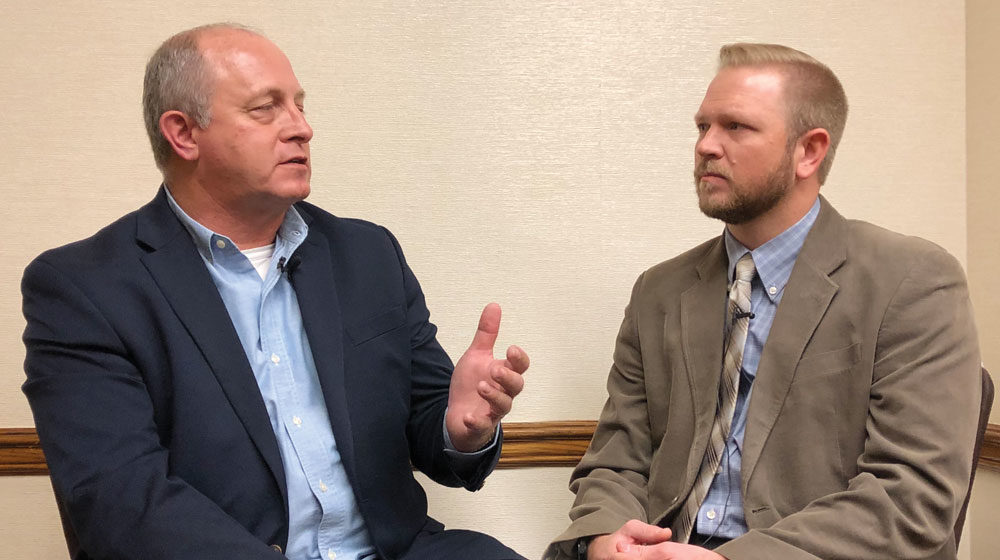Pictured Above: Mark Tibbets (r), vice president of sales for General Implement Distributors, and Craig Harthoorn (l), president of H&S Manufacturing, sat down during a break from the action at the Equipment Marketing & Distribution Assn. Fall Convention, to discuss their relationship as a distributor and manufacturer, including how Tibbet’s company handles carrying competing lines.
Mark Tibbets, Vice President Sales, General Implement Distributors
Craig Harthoorn, President, H&S Manufacturing
Mark Tibbets: I’ve been with General Implement Distributors for almost 15 years. We’re a distributor based out of Salt Lake City, Utah, with six locations that each have warehouses. General Implement a Division of Arnold Machinery Co. has been in business for 90 years, starting with wholesaling farm machinery in 1938. We have 16 territory salespeople that are delivering equipment, selling equipment, promoting products, doing demos and field demonstrations.
Craig Harthoorn: H&S Manufacturing manufactures equipment within the livestock industry, forage and hay products and feeding equipment. We’re tied to the dairy industry, beef industry and other livestock industries. We have three different distribution channels: primary distribution channel, distributors, and business through the OEMs.
We work with a distribution network because of our product lineup. With our product line, it isn’t practical for us have multiple distribution centers across the country, therefore we work with distributors in the western U.S.
It’s difficult for us to deal with the issues of freight and the ability to service that distance from our headquarters. We seek out distributors to help fill that gap for us. We hold customer support in high regards, and we want distributors who’ll follow through on that. If a customer’s not happy, they’re going to seek out whose name is on the equipment.
Tibbets: A distributor’s role is to bridge that gap between the manufacturer and dealer. As a distributor, we work with our manufacturers to take care of the dealer after the sale. Our salespeople have built strong relationships with our dealers by doing this.
“We’re very open with our manufacturers when there’s competition. Because we have an account with almost all of the dealers near us, there are times where there are lines from multiple companies…”
Harthoorn: I love that aspect of the farm equipment industry — it’s all about relationships selling. It’s what makes our business so enjoyable. We want to leverage those relationships that good distributors offer.
Per your question about a company feeling out of touch with dealers when it goes through distributors, it depends on the legwork you do upfront in trying to partner with a good distributor. We rely on our distributors for product feedback on warranty, product enhancements or development ideas. Without our distributors, we’d be building our mousetrap the same way and telling them that’s the only way you can sell it.
We know we’re not perfect. You must be willing to accept constructive criticism from your distributor to improve yourself and to ensure long-term relationships.
Tibbets: It doesn’t matter how perfect the process might be, there’s going to be a hiccup. At the same time, distributors aren’t perfect. Balance and communication make us successful.
Harthoorn: Part of my job is to look at our product line annually. I ask, “have we reached the end of its product life cycle? Is it something that we need to completely revamp or slowly phase out?” Do you look at that yourself as a distributor? Do you do product rationalization, or do you just simply cut down your inventory and let it die?
Tibbets: We watch our numbers very closely all year long and we go through and report on what we do each month with every manufacturer. Then at the end of the year, we compile all of the information and look at our gross margin ROI on all of our manufacturers and set it to 100. If the GMROI is below our standard, we need to figure out why. We review those and make sure that what we have is still relevant.
We’re very open with our manufacturers when there’s competition. Because we have an account with almost all of the dealers near us, there are times where there are lines from multiple companies. We have some dealers that are only going sell one brand and so we’re going to push that brand products at those dealerships. Dealers are given a territory to sell in, so that dealer will sell the competing product line.
“You must be willing to accept constructive criticism from your distributors to improve yourself and to ensure long-term relationships…”
We’ve had a couple of instances where we were approached and had to say, “We need a discussion with our current supplier first as it’s a similar product.” We ask, “Are you OK with this? If you’re not, we won’t take it on.” We try to be as upfront as possible because these relationships are not worth giving up over a new line.
Harthoorn: We want to become our distributors’ preferred vendors. We take it as a challenge and it’s something we closely watch. On a regular basis we’ll ask you, “How are you doing? Is there something that we’re not doing? Are there things we need to do better? Is there a hole in our product line that we can fill? What can we do better to make sure we are your one of your preferred vendors?”
Tibbets: If sales are going down on this line, but they’re up over here, you have to ask if it’s feasible and realistic that we hold onto this line. We don’t simply hold onto a line to prevent anybody else from getting it.
Harthoorn: It’s important to work with a distributor that’s willing to do the very same thing. They must have the same work ethic and the willingness to self-critique.
Conversations in Ag: Introduction
Commercial Vehicle Business vs. Ag Equipment
Shortliners Ask: Is Ag’s Future Autonomous?
Women Add a Different Perspective to the Sales Process
2 Industries, 1 Problem: Recruiting Technician
33 Years Later: Lessons Learned Make Today’s Dealers Stronger
Hemp’s Future: What Will Happen When the Dust Settles?
Early Experience & Advantage in European Brands
Two Sides Examine 2-Step Distribution
Overcoming Adversity Through Technology & Diversity
Getting Real: Farmers Growing Too Much Corn...
Research: Can It Be a Dealership’s Business?
Dealer Structures: Europe, North America a World Apart
Trading Places: Farmer vs. Dealer Expectations
Dealer & Economist Compare Notes on Challenges Global Economy has on U.S. Agriculture
Avoiding Hefty Fines When Doing Business Out of State
Thinking Ahead: How Should Dealers Prepare A Succession Plan?







